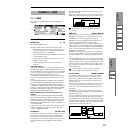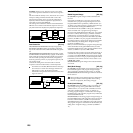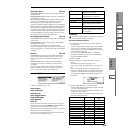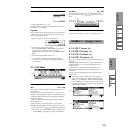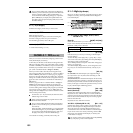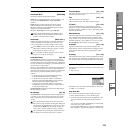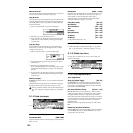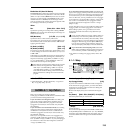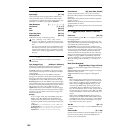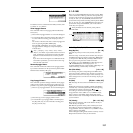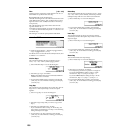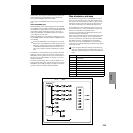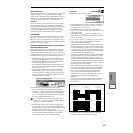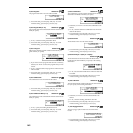
GLOBAL
1.1
2.13.14.15.16.1
GLOBAL
1.1
2.13.14.15.16.1
135
Enable Note Off (Note Off Receive)
On (checked): Note-off messages will be received. Normally
you will uncheck this. This parameter is valid when “Hold”
(PROG 2.1–1b) is checked (Hold On). In the case of a drum
program, you will normally select Hold On. In this case if
“Enable Note Off” is checked, note-off messages will be
received, and the sound will stop (the release segment of the
EG will begin) when the key is released.
Mixer:
Pan [Rndm, L001...C064...R127]
Specifies the panning for each key. With a setting of Rndm
(Random), the panning of the drumsample will change ran-
domly for each note-on.
BUS (Bus Select) [L/R, IFX, 1, 2, 1/2, Off]
Specifies the bus to which each key will be sent.
For example you can send snare-type sounds to IFX to apply
the insert effect, and send the other sounds to L/R without
applying the insert effect.
S1 (Send1 (to MFX1)) [000...127]
S2 (Send2 (to MFX2)) [000...127]
For each key, specify the send levels to master effects 1 and
2. These settings are valid when “BUS Select” (5.1–3a) is set
to L/R or Off.
If “BUS Select” is set to IFX, the send level to master effects 1
and 2 will be determined by the Program, Combination, or
Sequencer mode Setup pages (PROG/COMBI 7.1–2, SEQ
7.1–3) S1 (Send1(MFX1),” “S2 (Send2(MFX2)” which are
located after the sound passes through IFX.
Drum kits will sound using the settings of the program
that is selected in Program mode. These settings are
valid only if “Use DKit Setting” (PROG 5.1–1b) and
“Use DKit Setting” (PROG 7.1–1a) are checked. Be
aware that the results of editing a drum kit will not be
reflected unless these settings have been made in the
program.
■ 5.1–3b: UTILITY
☞“Write Drum Kits,” “Rename Drum Kit,” “Copy Drum
Kit,” “Copy Key Setup” (5.1–1d)
Here you can create user arpeggio patterns.
In this page, the TRITON Le will sound as it did in the mode
you were in before entering Global mode.
If you moved here from Program mode: Your editing will
apply to the arpeggio pattern that is selected by the pro-
gram. Even if you moved from a program in which the
arpeggiator is turned off, it can be turned on by the [ARP
ON/OFF] key.
If you moved here from Combination mode: Your editing
will apply to the arpeggio pattern that is selected by the
combination. Even if you moved from a combination in
which the arpeggiator is turned off, it can be turned on by
the [ARP ON/OFF] key.
However, it is not possible to turn on an arpeggiator for
which the A or B parameter is unchecked in “Arpeggiator
Run” (COMBI 1.1–4(5)a, COMBI 6.1–1a). Also, the arpeggia-
tor will not run unless it has been assigned to a timbre in
“Assign” (COMBI 6.1–1b).
If you moved here from Sequencer mode: Your editing will
apply to the arpeggio pattern specified for the selected song.
Even if you moved here from settings in which the arpeggia-
tor was turned off, you can use the [ARP ON/OFF] key to
turn it on. However, it is not possible to turn on an arpeggia-
tor for which the “Arpeggiator Run” (SEQ 6.1–1(2)a) param-
eter A or B is not checked. Also, the arpeggiator will not
operate if it has not been assigned to a track in “Assign”
(SEQ 6.1–1(2)b).
In each of the above cases, you can modify the settings of the
arpeggio pattern even if the arpeggiator is not turned on.
When editing a pattern, it is a good idea to turn on the
arpeggiator and make sure that it is the pattern that you
wish to edit.
If you want the edited user arpeggio pattern settings to
be backed up even when the power is turned off, you
must write them into memory. Select the Utility “Write
Arpeggio Pattern” to access the Write Arpeggio Pattern
dialog box. Alternatively, press the [REC/WRITE] key
to access the “Update Arpeggio Patterns” dialog box.
Then press the [F8] (“OK”) key to write the edited data.
If you moved here from Sampling mode (if the EXB-
SMPL option is installed): The arpeggiator will not turn
on, nor will it be possible to edit the arpeggio pattern.
☞For details on creating an arpeggio pattern, refer to BG
p.99.
6.1–1: Setup
6.1–1a: Arp, pat (Pattern), (Tempo)
Arp (Arpeggio Select) [A, B]
If you have moved from Combination mode or Sequencer
mode and edit an arpeggio pattern, you must select either
arpeggiator A or B as the pattern to edit. Your editing will
apply only to the selected one.
B will not be displayed if you moved here from Program
mode.
Pat (Pattern) [P000...P004, U000(INT)...U215(User)]
Selects the pattern that you wish to edit.
(Tempo) [040...240, EXT]
Specify the tempo.
This can also be adjusted by the REALTIME CONTROLS C-
mode [TEMPO] knobs. If “MIDI Clock” (2.1–1a) is External,
the display will indicate EXT and the arpeggiator will syn-
chronize to MIDI Clock messages from an external MIDI
device.
GLOBAL 6.1: Arp.Pattern
P000 …P004 Preset Arpeggio Patterns
U000(INT)...199(INT) Preload Arpeggio Patterns
U200(User)...215(User) for user Arpeggio Patterns
6.1–1c
6.1–1a
6.1–1b
6.1–1e6.1–1d



